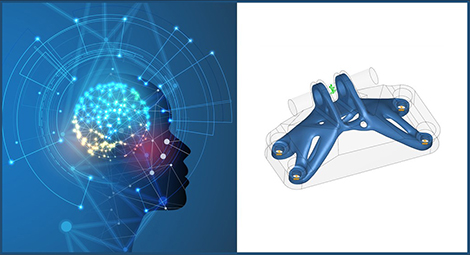
PTC has announced that it has acquired Frustum, a start-up focused on a range of topology optimisation tools, based in New York.
Founded by Jesse Coors-Blankenship, Frustum’s technology will now be brought into the PTC fold. And the price for that shiny new tech? A cool $70 million.
According to PTC’s announcement: “Frustum offers patented desktop and cloud-based engineering software that enables designers and engineers to go beyond the limits of their personal experience by leveraging powerful AI capabilities that guide the discovery of high-performance, next-generation product designs.”
PTC CEO Jim Heppelmann had more effusive things to say about the acquisition, adding: “PTC is pushing the boundaries of innovation with this acquisition.
“Creo is core to PTC’s overall strategy, and the embedded capabilities from Ansys and, later, Frustum will elevate Creo to a leading position in the world of design and simulation.
“With breakthrough new technologies such as AR/VR, high-performance computing, IoT, AI, and additive manufacturing entering the picture, the CAD industry is going through a renaissance period, and PTC is committed to leading the way.”
The last few years have seen a huge ramp up of interest in the subject of topology optimisation – something that we’ve talked about a lot over the years. Partly driven by 3D design software vendors desire to find an angle into the hype-cycle surrounding additive manufacturing and partly driven by a need to find something new to talk about, topology optimisation has become the must have feature for both simulation vendors and design software developers alike.
There’s no doubt that this technology is useful – it has been useful for the last two decades or more and there’s a lot of it around. As well as the start-ups that gain a lot of the attention, tools like OptiStruct from Altair Engineering (or its more mainstream Inspire cousin) have been around for a long while.
It’s also interesting about PTC are framing this. Reading the quote from Heppelmann, there’s a lot of talk about Artificial Intelligence.
Unless we’re very much mistaken, there’s almost no A.I. or machine learning inside of Frustum’s technology – it’s a very nifty, GPU driven topology optimisation engine that outputs a pretty nice, smooth meshed part. Yes, its more advanced TruSolid application looked promising when we saw it demonstrated at DEVELOP3D Live earlier this year, but again, no A.I. per se.
This tagging of Topology optimisation/generative design with the AI tag isn’t the sole preserve of PTC/Frustum – it’s prevalent from other vendors in the space (take a look at some of the nonsense in this Engadget piece on Autodesk’s recent project with NASA).
The Frustum acquisition also raised an interesting question around Siemens’ licensing of Frustum’s code for both Solid Edge and NX (it has been a flagship feature of the last few releases of both).
During PLM Europe, the man with the plan for NX, Bob Haubrock, brought into question the future of that relationship and now it, maybe, becomes clear why. We’ve asked both PTC and Siemens for clarification of the intent going forward and will update accordingly.
In terms of where PTC is heading, this is an interesting move. Considering it’s rampant desire to own the digital twin space, this is a curious move. Imagine having your engineering organization having access to a wealth of sensored, measured and rationalized data about how your product performs and is used in the field. Now, imagine plugging that into an efficient topology optimisation solver that’s integrated into your digital twin.
If you want to learn more about Frustum, this presentation from Jesse at DEVELOP3D Live UK is a pretty good place to start.






